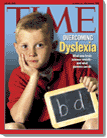|
We try to update our "In The News" section as often as possible to keep you informed on news articles and professional studies about learning differences, dyslexia and tutoring. We hope that you will be able to use this page as a resource for keeping up with what is happening in the field.
________________________________________________________________________________________
October 27, 2003

TIME Magazine Reveals the Mystery Behind the "New SAT" in its October 27 Issue
The College Entrance Examination Board has revised the standard format of the SAT that has become so familiar. The new test will be administered for the first time in the spring of 2005 and will stress different skill areas than the previous format. The analogies section will be removed from what was the verbal sections, and the quantitative comparisons will be missing from the math sections. There are now three main sections: Mathematics, Writing, and Critical Reading. The SAT will now feature math sections expanded to include content from third-year college preparatory math, short critical reading passages in addition to the longer reading passages, grammar questions and a student-written essay. The College Board felt it needed to alter the format to "improve the alignment of the test with current curriculum and institutional practices in high school and college."
What does this mean for today's high school sophomore and all who follow them? It means a broader approach to preparing for the SAT. A successful prep program will have to include more than just vocabulary. At The Reading Connection we are committed to working on fundamental rules of grammar, the elements of composition, and building an understanding of concepts from geometry through Algebra II will be integral to having success on the New SAT.
Click here for Information on The Reading Connection's SAT prep tutoring, with full explanations and sample questions from the New SAT.
For access to the TIME article, click here. (Archived articles cost $2.50 on the TIME website)
For information from the College Board about the New SAT, click here.
________________________________________________________________________________________
July 22, 2003

TIME Magazine Features Cover Story on Dyslexia in its July 28 Issue
This article brings nationwide attention to the difficulties that people with dyslexia go through. The author cites the statistic that there are currently over 3 million children in special education programs simply because they cannot read. The article examines the applications of this number on an individual, and biological level. It goes into some detail about recent studies on dyslexia that have provided greater insight into how dyslexics differ from normal readers. These studies have provided further support for the belief that students with dyslexia will benefit from remediation, even to the point where the "neurological glitch" that causes dyslexics to struggle with reading can be overcome entirely. ~TRC Staff
Read the article here (Archived articles cost $2.50) on the TIME website)
More resources provided by TIME
________________________________________________________________________________________
July 11, 2003
New Study on Writing Skills Shows Mixed Results
The "Nation's Report Card," put out every year since 1969 by the National Center for Education Statistics, released its Writing Assessment results yesterday. The 2002 study shows gains in the writing abilities of fourth- and eighth-graders, but again shows the low performance of high school seniors. Only last month, a federal study showed high schoolers' reading levels to be lower than expected. According to the latest release, 26 percent of 12th-grade students failed to even reach the basic writing achievement level. That number has gone up from 22 percent in 1998, the last time this version of the assessment was administered. The issue of writing ability has become a hot topic in recent years, as many educators blame the lower performances on the emphasis placed on reading and math skills for standardized testing. In an attempt to work on this problem, the College Board recently announced that a writing sample will be added as part of the SAT beginning in 2005.~TRC Staff
See the NCES Results, July 10, 2003
New York Times Article, July 11, 2003 - You may be required to register with the NY Times before viewing this article. Registration is free, and only required on your first visit. If the article is past two-weeks old, you may only be able to view an abstract without paying a fee. ________________________________________________________________________________________
June 30, 2003
Yale Researchers Identify Two Types of Childhood Reading Disability With Different Brain Patterns and Different Outcomes
Researchers at Yale University studied the brain activity of 43 young adults who had been diagnosed with reading disabilities and compared this data to a control group of good readers. By using M.R.I. scanners, the study found that there are two types of dyslexia - one in which the students compensate for the gap in their neural circuitry by employing other parts of the brain, and another where the students rely more on memory to overcome the disability. The former type was found to read with less difficulty than the latter. The study reinforces the fact that dyslexia can be effectively treated with remediation, since, as the lead researcher, Dr. Sally E. Shaywitz, said, "The persistently poor readers have a rudimentary system in place, but it's not connected well." Tutoring, especially when employed at an early age, can help to bridge this disconnect.~TRC Staff
Yale University Press Release, June 30, 2003
New York Times Article, July 8, 2003 - You may be required to register with the NY Times before viewing this article. Registration is free, and only required on your first visit. If the article is past two-weeks old, you may only be able to view an abstract without paying a fee.
|